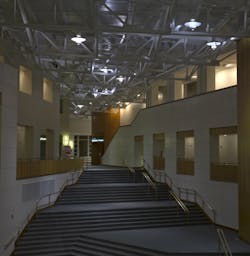DOE reveals Gateway data on LED wall wash retrofit at performing arts venue
SSL modules were used to retrofit existing fixtures that had previously hosted halogen lamps at the Clarice Smith Performing Arts Center located at the University of Maryland.
The US Department of Energy (DOE) has published the results of yet another LED-based lighting installation, this time in a performing arts venue on the University of Maryland (UMD) campus in College Park, MD. The project relied on solid-state lighting (SSL) modules to light hallways surrounding the atrium in the Clarice Smith Performing Arts Center (CSPAC). The retrofit of fixtures that had once housed halogen lamps has been deemed a success despite slightly lower light levels and different radiation patterns.
The primary motive for the LED retrofit was energy and maintenance savings, leading the Pacific Northwest National Laboratory (PNNL) staff representing the DOE and CSPAC staff to consider options for replacing 87 existing halogen fixtures. The existing lighting was operated 7300 hours per year and required constant maintenance both to re-lamp failed fixtures and even to adjust the aiming of operational fixtures. Moreover, some of the fixtures are located on high ceilings, requiring a lift for service. The team sought to use SSL while maintaining the visual appearance that both served to highlight the atrium boundaries and provide task lighting for the transition areas.
Interested in more articles and announcements on LED lighting projects?
The LED retrofit project was begun in early 2014 when the UMD facilities management looked for LED-based wall washers that could directly replace the fixtures and found limited options. The team needed products with similar looks in small and large sizes. And the size of the new fixtures was especially important because the facilities management did not want to be faced with refinishing the drywall ceiling, thereby adding to the cost and complexity of the project.
Ultimately, the team embarked on evaluation of two options to replace the smaller wall wash fixtures — The Lighting Quotient Elliptipar S222 fixture with Fraqtir optics and the TerraLux 6-in. Linear Line voltage modular light engine. Both the fixture replacement and retrofit options were mocked up and the team considered light over the range of 2700K–4000K CCT.
The products were being used to replace 150W halogens in the small fixtures. The 17W replacement luminaires did not light the top of the wall as well as the legacy lights and the beam was narrower. The 10W light engines retrofitted into the fixture more closely matched the existing lighting. The mockup also allowed the team to decisively choose 2700K LEDs. The halogens were rated at 2900K but were generally dimmed, which in the case of halogen technology resulted in a drop to the 2700K range.
Ultimately, the cost and complexity of installation made the LED retrofit option the clear path forward. The integral fixtures cost triple what the modules cost. Moreover, the fixtures were slightly smaller than the existing halogen fixtures and would have required minor ceiling repair. The retrofit process required less than an hour per fixture and was not considered more complex than the process of replacing fixtures.
The team also considered dimming. The modules were not rated by the manufacturer for dimming, but can work with some phase-cut dimmers. The mockup revealed that the performance was suitable for the application so long as the level was not dimmed to below 10%. The team did report minor flicker but judged it acceptable in the application.
Subsequently, a similar mockup and evaluation was performed on the larger fixtures. The halogen lamps in each fixture were rated at 300W. The team tested an LED retrofit that used two 13W TerraLux 8-in. light engines and determined it to be a good match to the light pattern.
The full DOE report on the retrofit with detailed results is available on the DOE SSL website. After the project was completed in the spring of 2015, the team made detailed measurements on light levels, color, and beam patterns throughout the facility. The final report includes some data on lights that had been operating for more than 5000 hours since the small fixtures had been installed before the large ones.
The report notes some changes in the amount of light reaching the walls and floor with the LED modules in place. Moreover, there were small distributions in pattern and smaller changes in color appearance. The report notes that lighting designers/specifiers should consider the importance of such issues in projects but also noted that the CSPAC team is happy with the results attained.
The small fixtures were retrofitted in late 2014. As the DOE report was produced, the team reported that no maintenance had been required on either of the fixture types. Considering the results, the DOE said that UMD facilities management is initiating more LED retrofit projects across the campus.
The DOE has published the results of a number of its Gateway demonstrations in indoor and outdoor projects. An interesting indoor example is focused on LED lighting used in museums. There was also a Gateway report on LED lighting used in a performance venue at the University of Florida.

Maury Wright | Editor in Chief
Maury Wright is an electronics engineer turned technology journalist, who has focused specifically on the LED & Lighting industry for the past decade. Wright first wrote for LEDs Magazine as a contractor in 2010, and took over as Editor-in-Chief in 2012. He has broad experience in technology areas ranging from microprocessors to digital media to wireless networks that he gained over 30 years in the trade press. Wright has experience running global editorial operations, such as during his tenure as worldwide editorial director of EDN Magazine, and has been instrumental in launching publication websites going back to the earliest days of the Internet. Wright has won numerous industry awards, including multiple ASBPE national awards for B2B journalism excellence, and has received finalist recognition for LEDs Magazine in the FOLIO Eddie Awards. He received a BS in electrical engineering from Auburn University.






